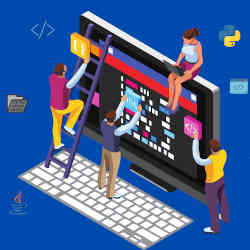
No-code artificial intelligence (AI) tool sets out to demystify and democratize AI by providing non-technical users with code-free environments for building AI models. No-code tools use techniques like intuitive interfaces, templates, and drag-and-drop editors to build AI for tasks like image recognition, object detection, data classification, and predictive analytics.
Here, we look at some of the no-code products currently available— from free computer vision tools for home users to enterprise-level platforms.
A Web-based computer vision app for classifying images and audio clips. Aimed at home users.
What does it do?
An uncluttered interface offers three categories of project to pick from: image, audio, or pose (body positions). Training data—image files and one-second audio clips—can be uploaded or captured via a Webcam or mic. Users group these examples into classes, and the model then is trained to recognize the class to which a new image or audio clip belongs. Playful demos include determining whether a banana is ripe or not, and recognizing which way a person is tilting their head; more complex applications are also featured on the Website.
The app is a Google product built on the TensorFlow.js library, and the code is available on github. The image and pose models learn off pretrained mobilenet neural networks, and the audio model uses Speech Command Recognizer.
Cost: Free
Microsoft also launched a no-code computer vision tool for home users. Lobe provides project templates for image classification, allowing people to collect and label images, then train and export the resulting AI models. Examples include the classification of plant species, hand gestures, and emotional reactions. Object detection and data classification model templates are slated to be added in the future.
Cost: Free
Automated machine learning (AutoML) for predictive analytics. Aimed at "data-savvy" professional users with no coding skills.
What does it do?
Work in Akkio takes place on a dashboard, called a Flow Navigator, where users build flows; these are 'end-to-end' AI models, in that they cover the entire process from inputting training data to model deployment. Structured data can be uploaded in tabular formats like CSV, Excel, or JSON. Predictive models are built automatically using variables defined by the user and based on categories in the connected dataset.
Results can be reviewed and analyzed within the Flow Navigator and deployed using an Application Programming Interface (API) and tools like Salesforce and Snowflake. Online demos include models for tasks such as text classification, detecting credit card fraud, and forecasting.
Cost: Subscription plans start at $60 per month.
Natural Language Processing (NLP) for cleaning, analyzing, and visualizing text-based customer interactions. Aimed at businesses of any size.
What does it do?
Text-based data— like customer emails, reviews, surveys, and social media—can be uploaded to the dashboard in formats such as CSV and Excel, or directly integrated via interfaces such as API or Zapier. MonkeyLearn then automatically tags text for analysis using 'classifiers', to classify text into categories such as topic or sentiment, and 'extractors', to extract specific data such as keywords or dates from the text.
There are options to use premade or custom-built classifiers and extractors, as well as templates for specific use-cases like social media or feedback surveys. The tags then are used for data analysis and visualization either within the MonkeyLearn environment or by connecting to other tools, including Tableau, Looker, and Google Data Studio.
Cost: Subscription plans start at $299 per month.
An enterprise-level platform for AI projects with multiple contributors. Aimed at organizations.
What does it do?
DataRobot is a cloud-based platform designed for professional users, including software engineers, business analysts, and executives, who are working collaboratively. Capabilities include data preparation, no-code AI model building and monitoring, and data analysis and visualization. There are options to automate machine learning (ML) and to build AI applications based on visual, text, and geospatial (location) data. The platform also offers pre-built templates and drag-and-drop widgets for deploying and reviewing models.
DataRobot's work environment is called the AI Cloud. Tailored AI Clouds have sector-specific features for the likes of healthcare, retail, manufacturing, and oil and gas. A comprehensive resources section includes technical documentation, webinars, tutorials, and a community forum.
Cost: Customized subscription packages via a quote. Standard contract term is three years.
A no-code tool for automating repetitive tasks on unstructured data. Aimed at businesses of any size.
What does it do?
Levity's end-to-end workflow is based around AI Blocks. Users create a 'block' by importing unstructured training data, including text, PDFs, and images, into the platform's interface. They then can opt to train using customized algorithms or pre-trained models. Completed blocks can be chained together and exported via a drag-and-drop interface called the Flow Editor; they can also be integrated with tools like Google Sheets, Zapier, and Slack.
Multiple use-cases are listed including automatically tagging images, moderating content, and categorizing service requests and Instagram photos.
Cost: Subscription plans start at $200 per month.
Tools like Dreamweaver, WordPress, and Wix revolutionized Web design and development; today, almost anyone can build a website. Knowledge of programming languages such as HTML, Javascript, and CSS is not required; the work happens 'under the bonnet' and is unseen by the user.
If no-code AI follows the same trajectory, it will make our increasingly AI-powered world more accessible, and perhaps even more acceptable, to society as a whole.
Karen Emslie is a location-independent freelance journalist and essayist.



Join the Discussion (0)
Become a Member or Sign In to Post a Comment